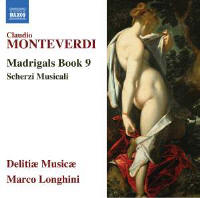Texte paru dans: / Appeared in: |
|
|
Reviewer: J.
F. Weber
In Fanfare 41:1 I was a
little too quick to announce the completion of Marco Longhini’s Monteverdi
series (long after it was recorded), since I noted further along in the
review that the present disc (recorded just a year later) was on its way.
His series now matches the contempora-neous series by Claudio Cavina and the
more recent series by Krijn Koetsveld. Cavina found room on his disc of Book
1 to record 12 pieces from Book 9, omitting, as he noted, the four other
pieces that were reprinted from Book 8 and recorded there. Koetsveld
recorded the four pieces again (as shown by the dates of recording), filling
a whole disc with his Book 9. Longhini goes further, recording the 12 unique
pieces of Book 9 and six pieces published in Scherzi musicali in
1632. In the track list, he references the four other pieces of Book 9 where
they are found in his Book 8 set, and he likewise refers to Zefiro torna
and Armato il cor as first published in the 1632 book. The former,
reprinted in Book 9, is sung only in that group and the latter, reprinted in
both Book 8 and Book 9, is sung only in Book 8. To avoid any confusion, he
adds a comment that Su, su, su pastorelli vezzosi as found in Book 9
is given a different musical setting than in Book 8. The Marini sinfonia
begins the program as an introduction to Bel pastor. It should be
noted that a couple of years later Cavina assembled a program titled
Scherzi musicali that included the six unique pieces of the 1632, set
along with seven others from various sources (33:3). That disc employed only
one singer, soprano Emanuela Galli. Five of those other pieces were included
in the miscellaneous madrigals that filled out the second disc of Longhini’s
Book 6.
Among the
three complete sets, Cavina was issued at full price but is now available as
a boxed set for not much more than Koetsveld’s boxed set. That leaves
Longhini’s prices at a disadvantage. I preferred Cavina when the single
discs were at full price, so if you didn’t buy them early, his boxed set is
now the first choice. Koetsveld is a viable alternative, but Longhini brings
out the meaning of every text in a way that gives his set a special appeal.
The sound is caught up close. If you have been collecting Longhni’s series,
add this one. | |
|
|
|
|
|
|
|
Cliquez l'un ou l'autre
bouton pour découvrir bien d'autres critiques de CD |
|




